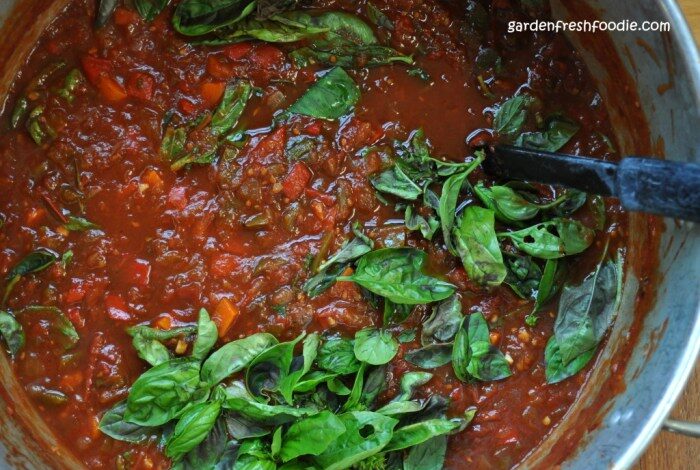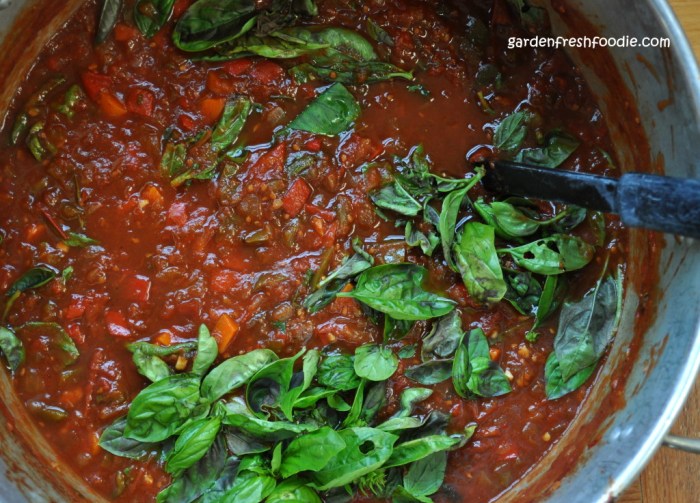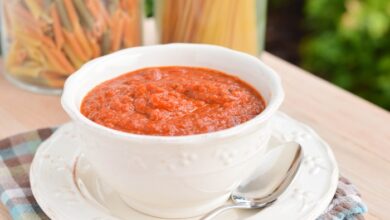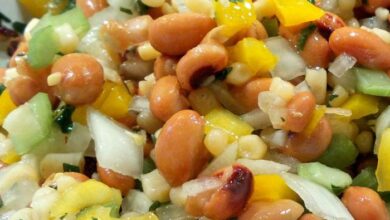
Fresh Garden Tomato Sauce: A Taste of Summer
Fresh garden tomato sauce, it’s more than just a condiment, it’s a taste of summer sunshine bottled up. The vibrant red hue, the intoxicating aroma, and the burst of flavor that dances on your tongue – all tell a story of sun-kissed tomatoes, nurtured with love, and transformed into a culinary masterpiece.
Forget the bland, mass-produced versions, because homemade tomato sauce is a revelation, a journey of fresh ingredients and flavor that’s simply unmatched.
There’s a certain magic in crafting a batch of homemade tomato sauce. You’re not just following a recipe, you’re creating an experience. From the careful selection of ripe, juicy tomatoes to the slow simmer that unlocks their hidden depths of flavor, every step is an act of culinary alchemy.
And the best part? You get to control the ingredients, ensuring a sauce that’s free of preservatives, additives, and unnecessary sugars, allowing you to enjoy the pure, unadulterated essence of the tomato.
Fresh Garden Tomato Sauce
There’s a world of difference between the vibrant, bursting flavors of a fresh garden tomato sauce and the commercially produced varieties found in supermarkets. While convenience is undeniable, homemade tomato sauce offers a unique experience, unlocking the true potential of these juicy, sun-ripened fruits.
Importance of Fresh, Ripe Tomatoes
Using fresh, ripe tomatoes is paramount to achieving the optimal flavor and texture in your homemade tomato sauce. Ripe tomatoes are bursting with sweetness, acidity, and a complex flavor profile that cannot be replicated with canned or processed tomatoes. Their flesh breaks down easily during cooking, creating a velvety smooth sauce.
The vibrant red color of ripe tomatoes indicates their peak ripeness and optimal flavor.
My fresh garden tomato sauce is perfect for so many dishes, but lately I’ve been loving it with a simple, flavorful Mexican inspired chicken thigh and rice skillet. The bright acidity of the sauce cuts through the richness of the chicken and rice, creating a delicious balance of flavors.
It’s a quick and easy weeknight meal that always hits the spot.
Ingredients and Preparation
The foundation of any great tomato sauce lies in the quality of the ingredients, particularly the tomatoes. A fresh garden tomato sauce uses tomatoes at their peak ripeness, bursting with flavor and juiciness. This section will guide you through the essential ingredients and the steps involved in preparing a delicious fresh garden tomato sauce.
The aroma of fresh garden tomato sauce simmering on the stove is a summer staple, and this year I’m pairing it with something truly indulgent – crispy, golden gluten free fried cheese curds. The tangy, gooey cheese curds are the perfect counterpoint to the sweet, savory sauce, and together they make for a truly satisfying meal.
I’m already dreaming of the next batch of tomato sauce, and I know exactly what I’ll be dipping them in!
Tomato Selection and Preparation
Selecting the right tomatoes is crucial for a flavorful sauce. Choose ripe, blemish-free tomatoes, preferably heirloom varieties known for their intense flavor.
- Ripeness:Look for tomatoes with deep red color, a slight give when gently pressed, and a sweet aroma. Avoid tomatoes that are green, wrinkled, or have soft spots.
- Variety:Heirloom tomatoes, such as Roma, San Marzano, or Brandywine, are excellent choices for sauce due to their low water content and concentrated flavor.
- Washing:Wash the tomatoes thoroughly under cool running water to remove any dirt or debris.
- Blanching:Blanching the tomatoes (briefly immersing them in boiling water) helps loosen the skins, making them easier to remove.
- Skin Removal:After blanching, plunge the tomatoes into ice water to stop the cooking process. The skins should now easily peel off.
- Chopping:Once peeled, chop the tomatoes into desired sizes, depending on your preference. Smaller pieces will create a smoother sauce.
Additional Flavor Enhancers
While tomatoes are the star ingredient, adding other elements can elevate the sauce to new heights. Consider these flavor enhancers:
- Herbs:Fresh herbs like basil, oregano, thyme, and rosemary add depth and complexity to the sauce.
- Spices:A pinch of garlic powder, onion powder, or red pepper flakes can add a subtle kick.
- Vegetables:Adding chopped onions, carrots, or celery can add sweetness and body to the sauce.
- Other Ingredients:Consider adding a splash of red wine, a tablespoon of sugar, or a pinch of salt and pepper to balance the flavors.
Cooking Methods and Techniques
The art of crafting a delicious tomato sauce lies in the cooking methods employed. Whether you prefer a quick simmer or a slow, deliberate roast, each technique contributes to the sauce’s final flavor profile and texture.
Simmering
Simmering is a gentle cooking method that involves maintaining a low, consistent temperature, allowing flavors to meld and deepen over time. This technique is particularly well-suited for tomato sauces, as it helps to break down the tomatoes’ acidity and develop a rich, complex flavor.
- Gentle Heat:Simmer the sauce over low heat, allowing the tomatoes to release their natural sugars and create a concentrated flavor.
- Regular Stirring:Stir the sauce occasionally to prevent sticking and ensure even cooking.
- Time and Patience:Simmering typically takes at least 30 minutes to an hour, allowing the flavors to develop fully.
Roasting
Roasting tomatoes intensifies their sweetness and brings out their natural caramelized flavors, resulting in a sauce with a more robust and concentrated taste. This technique is ideal for creating a sauce with a deeper, more complex flavor profile.
- High Heat:Roast the tomatoes at a high temperature, typically around 400°F (200°C), to encourage caramelization.
- Simple Seasoning:A touch of olive oil, salt, and pepper is usually sufficient to enhance the tomatoes’ natural flavors during roasting.
- Blistering:Roasting the tomatoes until they are slightly blistered on the outside helps to concentrate their flavors and add a hint of smokiness to the sauce.
Blending
Blending the cooked tomatoes is an essential step in creating a smooth and velvety sauce. It helps to break down any remaining chunks of tomatoes and create a consistent texture.
- Immersion Blender:An immersion blender is ideal for blending the sauce directly in the pot, ensuring a smooth and consistent texture.
- Regular Blender:A regular blender can also be used, but it is important to work in batches to avoid overloading the blender.
- Desired Consistency:Blend the sauce to your desired consistency, whether you prefer a smooth, velvety sauce or a slightly chunky texture.
Slow Cooking
Slow cooking is a key technique for enhancing the flavor and reducing the acidity of tomato sauce. By cooking the sauce slowly over low heat, the tomatoes have ample time to release their natural sugars and create a more balanced flavor profile.
“Slow cooking allows the tomatoes to break down, releasing their natural sugars and creating a more complex and nuanced flavor.”
- Low and Slow:Cook the sauce over low heat for several hours, allowing the flavors to develop gradually.
- Flavor Development:Slow cooking allows the sauce to thicken naturally, resulting in a more concentrated and flavorful sauce.
- Acidity Reduction:The slow cooking process helps to break down the acidity of the tomatoes, resulting in a more balanced and palatable sauce.
Consistency and Texture
Achieving the desired consistency and texture of tomato sauce is crucial for its overall appeal. Whether you prefer a thick, rich sauce or a lighter, more fluid consistency, several techniques can help you achieve your desired result.
- Simmering:Simmering the sauce for an extended period can help to thicken it naturally as the liquid evaporates.
- Starch:Adding a small amount of cornstarch or flour can help to thicken the sauce quickly.
- Tomato Paste:Tomato paste is a concentrated form of tomatoes that can be used to add depth of flavor and thicken the sauce.
Flavor Variations and Pairings: Fresh Garden Tomato Sauce
The beauty of fresh garden tomato sauce lies in its versatility. You can easily adjust the flavor profile to complement your favorite dishes, creating a unique culinary experience every time.
Flavor Variations
Here are a few ways to add depth and complexity to your homemade tomato sauce:
- Classic Italian:A simple blend of garlic, basil, oregano, and a pinch of red pepper flakes adds a vibrant and familiar taste. The combination of these herbs is the hallmark of Italian cuisine, offering a robust and earthy flavor.
- Spicy Kick:For a fiery twist, add a generous amount of chili flakes or a chopped jalapeño pepper. The heat will add a kick to the sauce, making it perfect for spicy pasta dishes or as a topping for grilled meats.
- Herby Delight:Experiment with different herbs like thyme, rosemary, or parsley. Each herb brings a unique flavor profile, enriching the sauce with subtle nuances. For instance, rosemary adds a woodsy, slightly piney note, while thyme offers a more earthy, peppery flavor. Parsley, on the other hand, adds a bright, fresh flavor that complements the tomato sweetness.
I love the way fresh garden tomato sauce brings out the flavor of everything it touches, from pasta to pizza. And speaking of flavor, have you tried this awesome broccoli cheese casserole ? It’s a real crowd-pleaser, and the creamy cheese sauce would be even better with a touch of homemade tomato sauce mixed in.
It’s all about finding those little ways to elevate the simple things, right?
- Sweet and Savory:A touch of sweetness can balance the acidity of the tomatoes. Add a teaspoon of sugar or a splash of honey to enhance the natural sweetness of the sauce. This technique is especially helpful when using tomatoes that are slightly tart.
Adjusting Sweetness and Acidity
The sweetness and acidity of your tomato sauce are crucial factors that influence the overall taste. Here are some tips to achieve the perfect balance:
- Sweetness:If your sauce is too tart, add a pinch of sugar or a teaspoon of honey to balance the acidity. The sweetness will enhance the natural sweetness of the tomatoes, creating a more harmonious flavor profile.
- Acidity:If the sauce is too sweet, a squeeze of lemon juice or a splash of vinegar can add a touch of brightness and acidity. This will help to cut through the sweetness and create a more balanced flavor.
- Tasting:Remember to taste your sauce frequently throughout the cooking process. This allows you to adjust the sweetness and acidity to your preference.
Pairing Fresh Garden Tomato Sauce
The versatility of tomato sauce makes it an ideal companion for a wide array of dishes. Here are some pairing ideas:
- Pasta:Tomato sauce is a classic pairing for pasta dishes. It can be used in simple pasta recipes like spaghetti with meatballs or more elaborate dishes like lasagna. The sauce coats the pasta beautifully, providing a rich and flavorful base.
- Pizza:A generous layer of tomato sauce is essential for a delicious pizza. It provides a tangy and flavorful base for your favorite toppings, creating a symphony of flavors.
- Meat:Tomato sauce can be used as a marinade for meats like chicken or pork, adding flavor and moisture. It can also be used as a glaze for roasted meats, creating a beautiful caramelized crust.
- Vegetables:Tomato sauce can be used to create flavorful vegetable dishes. It can be used as a base for stews, soups, or as a sauce for roasted vegetables.
Preservation and Storage

Making a large batch of fresh garden tomato sauce is a great way to enjoy the taste of summer all year round. But with all that deliciousness, you’ll need to find a way to preserve it. Here are some methods to help you store your homemade tomato sauce for future use.
Canning
Canning is a traditional method for preserving tomato sauce. It involves heating the sauce to a high temperature to kill bacteria and sealing it in airtight jars to prevent spoilage. Canning requires careful attention to safety protocols to prevent botulism, a serious foodborne illness.
Here are the key steps involved in canning tomato sauce:
- Prepare the jars and lids:Wash jars and lids thoroughly in hot, soapy water. Sterilize jars by boiling them in water for 10 minutes.
- Heat the sauce:Bring the sauce to a rolling boil for at least 1 minute to ensure all bacteria are killed.
- Fill the jars:Pour the hot sauce into the sterilized jars, leaving about 1/2 inch of headspace at the top.
- Process the jars:Place the filled jars in a water bath canner, ensuring the water covers the jars by at least 1 inch. Process the jars according to the recommended time for tomato sauce, typically 45 minutes at a simmering boil.
- Cool and store:Carefully remove the jars from the canner and allow them to cool completely. Check the lids to ensure they are properly sealed. Store canned tomato sauce in a cool, dark place for up to a year.
Freezing
Freezing is another common method for preserving tomato sauce. It’s a simple process that doesn’t require specialized equipment. Freezing tomato sauce is a quick and easy method that can be done with readily available materials. Here’s how to freeze tomato sauce:
- Choose your container:Use freezer-safe containers like airtight plastic containers, freezer bags, or ice cube trays.
- Label and date:Label your containers with the contents and date of freezing.
- Freeze flat:For faster freezing and easier thawing, freeze the sauce in a flat layer in a freezer-safe container or bag.
- Store and thaw:Store frozen tomato sauce for up to 6 months. To thaw, transfer the sauce to the refrigerator overnight.
Dehydrating, Fresh garden tomato sauce
Dehydrating is a less common method for preserving tomato sauce, but it can be a good option if you want to create a concentrated sauce that has a long shelf life.Dehydration removes moisture from the sauce, creating a concentrated product that can be rehydrated later.
Here’s how to dehydrate tomato sauce:
- Prepare the sauce:Cook the sauce until it has thickened and reduced to a desired consistency.
- Spread on dehydrator trays:Spread the sauce in a thin layer on dehydrator trays, ensuring it is evenly distributed.
- Dehydrate according to instructions:Follow the instructions for your specific dehydrator, typically dehydrating the sauce at a low temperature (135-145°F) for several hours.
- Store in airtight containers:Once dehydrated, store the sauce in airtight containers in a cool, dark place.
Storage Conditions and Shelf Life
Proper storage is crucial for maintaining the quality and safety of preserved tomato sauce.
- Canned tomato sauce:Canned tomato sauce can be stored in a cool, dark place for up to 1 year.
- Frozen tomato sauce:Frozen tomato sauce can be stored in the freezer for up to 6 months.
- Dehydrated tomato sauce:Dehydrated tomato sauce can be stored in airtight containers in a cool, dark place for up to 1 year.
Safe Use and Reheating
When using preserved tomato sauce, it’s essential to follow safe handling and reheating practices.
- Canned tomato sauce:Always check the seal of the jar before using. If the seal is broken or the contents appear spoiled, discard the sauce.
- Frozen tomato sauce:Thaw frozen tomato sauce in the refrigerator overnight.
- Dehydrated tomato sauce:Rehydrate dehydrated tomato sauce by adding water and heating it on the stovetop.
Always reheat preserved tomato sauce thoroughly to a temperature of 165°F (74°C) to kill any remaining bacteria.
Tips for Growing Tomatoes
Growing your own tomatoes is a rewarding experience, offering fresh, flavorful fruit for your homemade sauce. Whether you have a small patio or a sprawling garden, with a little planning and care, you can cultivate a bountiful harvest.
Choosing Tomato Varieties
Selecting the right tomato variety is crucial for producing sauce-worthy tomatoes. Consider these factors:
- Flavor:Choose varieties known for their rich, concentrated flavor, as this will translate into a delicious sauce. Some popular sauce-friendly tomatoes include Roma, San Marzano, and Amish Paste.
- Size and Shape:Roma and San Marzano tomatoes are prized for their elongated shape and meaty flesh, ideal for processing into sauce. These varieties have fewer seeds and less juice, resulting in a thicker sauce.
- Yield:If you plan to make large batches of sauce, choose varieties known for their high yield. Roma and San Marzano tomatoes are typically productive, producing numerous fruits per plant.
- Disease Resistance:Choose varieties that are resistant to common tomato diseases like early blight, late blight, and fusarium wilt. This will help ensure a healthy harvest and minimize the need for chemical treatments.
Essential Gardening Techniques
Growing healthy and productive tomato plants requires a few essential techniques:
- Sunlight:Tomatoes thrive in full sun, requiring at least six hours of direct sunlight per day. Choose a location in your garden that receives ample sunshine throughout the day.
- Soil:Tomatoes prefer well-drained soil with a pH of 6.0 to 6.5. Amend the soil with compost or aged manure to improve drainage and add nutrients.
- Watering:Water tomatoes deeply and infrequently, allowing the soil to dry slightly between waterings. Avoid overhead watering, which can promote fungal diseases.
- Staking or Caging:Support tomato plants with stakes or cages to prevent them from sprawling and becoming susceptible to disease. This also helps with air circulation and makes it easier to harvest ripe tomatoes.
- Fertilizing:Fertilize tomato plants regularly with a balanced fertilizer, especially during the fruiting stage. Follow the manufacturer’s instructions for application rates.
Harvesting Tomatoes at Peak Ripeness
Harvesting tomatoes at the peak of ripeness is crucial for optimal flavor and sauce quality.
- Color:Tomatoes are ripe when they reach their full color, which varies depending on the variety. Roma tomatoes typically turn a deep red, while San Marzano tomatoes may have a slight orange hue.
- Firmness:Ripe tomatoes should be firm to the touch, but not hard. Avoid picking tomatoes that are soft or mushy.
- Aroma:Ripe tomatoes have a sweet, fruity aroma. If you’re unsure about the ripeness, give the tomato a gentle squeeze and sniff. A ripe tomato will have a distinct, pleasant scent.






